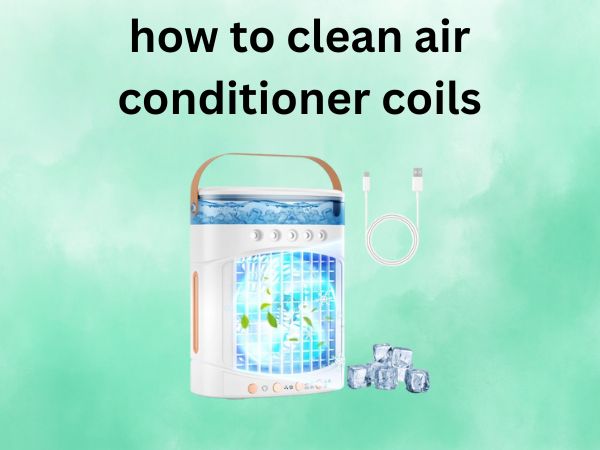How to Clean Air Conditioner Coils [The Ultimate Guide to Better Cooling]
Picture this: it’s the hottest day of summer, and your air conditioner is working overtime but barely keeping up. Before you panic and call for expensive repairs, the solution might be simpler than you think. Those dirty coils hiding inside your AC unit could be the culprit behind your cooling woes.
Cleaning your air conditioner coils isn’t just about maintenance – it’s about saving money, improving efficiency, and extending your system’s lifespan. In this comprehensive guide, we’ll walk you through everything you need to know about keeping your AC coils spotless and your home comfortably cool.
Table of Contents
Why Clean AC Coils Matter More Than You Think
Your air conditioner’s coils are like the lungs of your cooling system. Just as you wouldn’t expect to breathe properly through clogged airways, your AC can’t function efficiently with dirty coils. These metal components are responsible for the actual heat exchange that makes cooling possible.
When coils get clogged with dirt, dust, pet hair, and debris, they create a barrier that prevents proper heat transfer. Think of it like trying to drink a thick milkshake through a narrow straw – everything has to work much harder to get the job done. This extra strain doesn’t just impact performance; it drives up your energy bills and can lead to costly system failures.
Clean coils can improve your AC’s efficiency by up to 30%, which translates to significant savings on your monthly utility bills. Plus, you’ll enjoy more consistent temperatures throughout your home and cleaner indoor air quality.
Signs Your Air Conditioner Coils Need Cleaning
How do you know when it’s time to roll up your sleeves and tackle those coils? Your AC system will usually give you plenty of warning signs before things get critical.
Higher Energy Bills
Have you noticed your electricity bills creeping up without any obvious explanation? Dirty coils force your system to work overtime, consuming more energy to achieve the same level of cooling. If your bills have increased by 15-20% compared to previous years, contaminated coils might be the sneaky culprit.
Reduced Cooling Performance
When your AC is running constantly but your home feels like a sauna, it’s time to investigate. Clean coils facilitate efficient heat exchange, but dirty ones create bottlenecks in the cooling process. You might notice certain rooms staying warmer than others, or your system struggling to reach the temperature you’ve set on your thermostat.
Strange Odors and Noises
Musty or moldy smells coming from your vents often indicate moisture buildup on dirty evaporator coils. These damp conditions create the perfect breeding ground for bacteria and mold. Similarly, unusual sounds like hissing, bubbling, or grinding could signal that your system is straining against the resistance created by contaminated coils.
Understanding Your AC System: Evaporator vs Condenser Coils
Before we dive into the cleaning process, let’s clear up some confusion about the different types of coils in your air conditioning system. Many homeowners don’t realize they’re dealing with two distinct components that require different approaches.
What Are Evaporator Coils?
Evaporator coils live inside your home, typically housed within your indoor air handler or furnace unit. These coils contain cold refrigerant that absorbs heat from the air passing over them. As warm indoor air flows across these chilled coils, the heat gets absorbed, and cool air is circulated back into your living spaces.
Because evaporator coils are constantly exposed to moisture from the cooling process, they’re particularly susceptible to mold and mildew growth. The combination of moisture and dust creates a sticky film that’s tougher to remove than simple dust accumulation.
What Are Condenser Coils?
Condenser coils are located in your outdoor unit and have the opposite job of evaporator coils. They release the heat that was absorbed from inside your home into the outdoor air. These coils get hot during operation and are constantly exposed to outdoor elements like leaves, grass clippings, pollen, and dirt.
While condenser coils don’t deal with moisture issues like their indoor counterparts, they face different challenges. Their outdoor location means they’re bombarded with debris year-round, and their accessible location makes them easier to clean but more prone to damage from lawn equipment or harsh weather.
Safety First: Essential Precautions Before You Start
Cleaning AC coils involves working with electrical components and potentially sharp metal fins, so safety should be your top priority. A few minutes of preparation can prevent hours of problems later.
Power Down Your System
Never attempt to clean coils while your system is running. Turn off your air conditioner at the thermostat, then locate your electrical panel and flip the breaker that controls your AC unit. For extra safety, many outdoor units have a disconnect switch near the condenser – make sure this is also in the off position.
Wait at least 30 minutes after shutdown before beginning work. This allows the system to depressurize and gives hot components time to cool down. Remember, some parts of your AC system can reach temperatures exceeding 150°F during operation.
Gather Your Cleaning Arsenal
Having the right tools makes the difference between a successful cleaning session and a frustrating afternoon. You’ll need a screwdriver set for removing access panels, a flashlight or headlamp for better visibility, and protective gear including safety glasses and work gloves.
For cleaning supplies, grab a spray bottle, soft-bristled brush (an old toothbrush works great), clean cloths or paper towels, and a vacuum with a brush attachment. You’ll also want commercial coil cleaner or a homemade solution of warm water and mild dish soap.
How to Clean Evaporator Coils: Step-by-Step Guide
Indoor evaporator coils require a delicate touch since they’re surrounded by sensitive electrical components and located in tight spaces. The key is being thorough without being aggressive.
Accessing Your Indoor Coils
Locating your evaporator coils is the first challenge. In most homes, they’re housed inside the air handler unit, which could be in your basement, utility closet, attic, or garage. Look for a large metal box connected to your ductwork – this is your air handler.
Remove the access panel (usually held by screws or clips) to reveal the coils. They’ll look like a series of metal fins arranged in an A-frame or slab configuration. Take a photo before you start so you’ll know how everything should look when reassembled.
The Gentle Cleaning Process
Start by using your vacuum’s brush attachment to remove loose debris from the coil surface. Work carefully to avoid bending the delicate aluminum fins. Pay special attention to the areas where dirt typically accumulates, like the bottom of the coils where condensation drips.
Next, apply your cleaning solution using a spray bottle. Commercial coil cleaners are formulated to foam up and lift away stubborn grime, but a mild soap solution works well too. Allow the cleaner to sit for the recommended time (usually 5-10 minutes) to break down accumulated buildup.
Dealing with Stubborn Buildup
For areas with heavy contamination, use your soft brush to gently scrub the coil fins. Work in the same direction as the fins to avoid bending them. If you encounter bent fins, you can carefully straighten them with a fin comb (available at HVAC supply stores) or a butter knife.
Rinse thoroughly with clean water from a spray bottle, working from the inside out to push debris away from the coils. Use clean cloths to absorb excess moisture, and allow everything to air dry completely before reassembling.
How to Clean Condenser Coils: Outdoor Unit Maintenance
Outdoor condenser coils face different challenges but are generally easier to access and clean. The key is removing debris without damaging the unit or surrounding landscaping.
Preparing Your Outdoor Unit
Start by clearing the area around your condenser unit. Remove leaves, grass clippings, and any debris within a three-foot radius. This isn’t just for cleaning convenience – maintaining clear space around your unit improves airflow and prevents future contamination.
Remove the top grille or fan guard if possible (some units have removable guards, others don’t). This gives you better access to the coils and prevents water from hitting the fan motor during cleaning.
The Power Washing Technique
For heavily soiled condenser coils, a garden hose with a pressure nozzle can be highly effective. Start with lower pressure and work your way up as needed. Spray from the inside of the unit outward to push debris away from the coils rather than deeper into them.
Focus on one section at a time, working methodically around the entire unit. Pay attention to the bottom coils where heavier debris tends to settle, and don’t forget the sides that might be hidden by landscaping or fencing.
Alternative Cleaning Methods
If you don’t have access to a pressure washer or prefer a gentler approach, commercial coil cleaners designed for outdoor units work well. These cleaners are typically more aggressive than indoor formulations since they don’t need to be safe for enclosed spaces.
Apply the cleaner according to manufacturer instructions, allow it to work its magic, then rinse thoroughly with your garden hose. Some cleaners are designed to be left on without rinsing, but always read the label carefully.
When to Call the Professionals
While cleaning AC coils is definitely a DIY-friendly task, some situations call for professional expertise. If your coils are severely corroded, if you discover refrigerant leaks, or if your system uses specialized components, it’s worth investing in professional service.
Professional technicians have access to industrial-strength cleaners and specialized tools that can address problems beyond the scope of homeowner maintenance. They can also inspect your entire system for potential issues that might not be obvious to untrained eyes.
Consider professional cleaning if you have health concerns that make working around dust and cleaning chemicals problematic, or if your system is still under warranty and you want to avoid any actions that might void coverage.
Maintaining Clean Coils: Prevention Tips
The best coil cleaning strategy is preventing excessive buildup in the first place. A few simple habits can dramatically reduce how often you need to perform deep cleaning.
Regular Filter Changes
Your air filter is your first line of defense against coil contamination. A clean filter catches dust and debris before it reaches your coils, but a dirty filter becomes useless and can actually make contamination worse.
Check your filters monthly during peak usage seasons and replace them according to manufacturer recommendations. If you have pets, smoke indoors, or live in a dusty area, you might need to change filters more frequently than the standard 30-90 day intervals.
Seasonal Maintenance Schedule
Create a simple maintenance routine that fits your local climate. In most areas, spring and fall are ideal times for thorough coil cleaning. Spring cleaning prepares your system for the heavy usage of summer, while fall maintenance removes the accumulated debris from months of operation.
Keep outdoor units clear of vegetation, and trim plants regularly to maintain proper airflow. During fall, remove leaves promptly to prevent them from decomposing against your coils and creating acidic conditions that can cause corrosion.
Common Mistakes to Avoid
Even with the best intentions, DIY coil cleaning can go wrong if you’re not aware of common pitfalls. Here are the mistakes that cause the most problems for homeowners.
Never use harsh chemicals like bleach or ammonia-based cleaners on your coils. These can cause corrosion and create toxic fumes in enclosed spaces. Similarly, avoid using pressure washers on indoor coils or directing high-pressure water at electrical components.
Don’t attempt to clean coils without turning off power to the system. Even if the unit isn’t running, electrical components can still be energized and pose serious safety risks. Finally, resist the urge to use metal brushes or abrasive tools that can damage delicate coil fins.
FAQs
Q: How often should I clean my air conditioner coils? A: Most homeowners should clean their AC coils annually, ideally in spring before the heavy cooling season begins. However, if you live in a dusty area, have pets, or notice decreased performance, you might need to clean them twice yearly.
Q: Can I use household cleaners like dish soap to clean my AC coils? A: Yes, mild dish soap mixed with warm water is safe and effective for cleaning AC coils. Avoid harsh chemicals, bleach, or ammonia-based products that can damage coils or create dangerous fumes.
Q: What happens if I don’t clean my AC coils regularly? A: Dirty coils reduce efficiency, increase energy costs, and can lead to system failures. Severely contaminated coils can cause your AC to freeze up, overheat, or stop working entirely, resulting in expensive repairs or premature replacement.
Q: Is it safe to clean AC coils myself, or should I hire a professional? A: Basic coil cleaning is safe for most homeowners if proper safety precautions are followed. However, if you’re uncomfortable working with electrical components, have severely damaged coils, or discover refrigerant leaks, it’s best to call a professional.
Q: How can I tell if my coil cleaning was successful? A: After cleaning, you should notice improved cooling performance, more consistent temperatures throughout your home, and potentially lower energy bills over the following months. The coils themselves should look noticeably cleaner and allow better airflow through the fins.
Conclusion
Cleaning your air conditioner coils might not be the most glamorous home maintenance task, but it’s one of the most impactful things you can do for your cooling system. With clean coils, you’ll enjoy lower energy bills, better cooling performance, and a longer-lasting AC system.
The process doesn’t require expensive tools or advanced technical skills – just patience, the right approach, and attention to safety. By making coil cleaning part of your regular home maintenance routine, you’re investing in your comfort and your wallet’s wellbeing.
Remember, consistent maintenance is always easier and less expensive than emergency repairs. Your future self will thank you when you’re staying cool and comfortable while your neighbors are dealing with costly AC breakdowns.



